 German Empire (1900), Armoured Cruiser 1902-1920
German Empire (1900), Armoured Cruiser 1902-1920WW1 German Cruisers
Irene class | SMS Gefion | SMS Hela | SMS Kaiserin Augusta | Victoria Louise class | Prinz Adalbert class | SMS Prinz Heinrich | SMS Fürst Bismarck | Roon class | Scharnhorst class | SMS BlücherBussard class | Gazelle class | Bremen class | Kolberg class | Königsberg class | Nautilus class | Magdeburg class | Dresden class | Graudenz class | Karlsruhe class | Pillau class | Wiesbaden class | Karlsruhe class | Brummer class | Königsberg ii class | Cöln class
Setting up a standard- The Prinz Heinrich:
The SMS Prinz Heinrich (“Prince henry”) was a single German armored cruiser (called “heavy cruiser” in German nomenclature), built in 1898-1901 for the Kaiserliche Marine. She was named in honor of Kaiser Wilhelm II’s younger brother. She was the second German armoured crusier, drawing much from the previous Fürst Bismarck, but also improving in many point, so much she was seen as the forerunner for subsequent armoured cruisers. SMS Prinz Heinrich entered service in March 1902, and served from 1906 as the scouting forces fleet’s flagship. She became a gunnery training ship from 1908 to 1912 and she underwent modernization and conversion into a dedicated training ship in 1914, for future crews of armoured cruisers. But her participation in WW1 was not limited to second line duties: Fully reactivated she acted as coast defense ship and took part in the fleet supporting the Raid on Scarborough, Hartlepool and Whitby in December 1914, destined to lure out British battlecruisers. She soldiered on in the Baltic sea in 1915 but was disarmed in 1916 and took secondary roles until the end of the war.
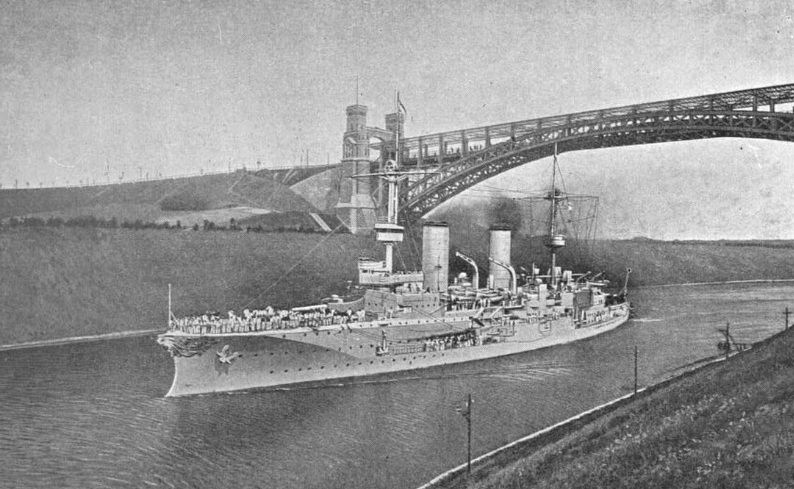
SMS Prinz Heinrich through the Kiel Canal
Design of the Prinz Heinrich
SMS Prinz Heinrich was the second armored cruiser built in Germany, authorized under the 1898 Naval Law, Alfred von Tirpitz’s ambitious naval construction program when he arrive at the head of the State Secretary of the Reichsmarineamt, Imperial Naval Office. Her design was prepared while construction of the Fürst Bismarck was underway so there was the risk of not taking account of early service lessons. Naval historians like Hugh Lyon or John Taylor stated in the 1970s that the new cruiser was intended for overseas service to what more recently Aidan Dodson said that she was neither wooden sheathed not copper/zinc sheated seen by that time as a necessity on a place where shipyard facilities would be scarce. That’s the main difference in the design compared to Fürst Bismarck: She was the first German armoured cruiser intended for the north and baltic sea, and to operate with the Kaiserliches Marine (and the future Hochseeflotte).
The design staff did not started from scratch though, but elaborated their design on the Fürst Bismarck. Budget restrictions meant they even had to curtail her size from 1,500 metric tons, achieved by thinning her armor layout, and thanks to advances in steel manufacturing, which thanks to the new cemented armour by Krupp, strength was still equivalent. In fact, due to this new plating and better layout arguably, her armoyur scheme was even significantly more effective. Krupp cemented armor was indeed considerably stronger than Harvey armor and became quickly popular around the world, many ships of that era being ordered with German plating. Prinz Heinrich therefore on paper had a weaker armor, but made with a stronger steel, whereas this reduced weight meant engineers were able to extended the belt up to the main deck level. Her deck armor was also better sloped down on both sides where as connected to the lower edge of the belt, so creating in affect another armor layer to penetrate for any incoming shell.
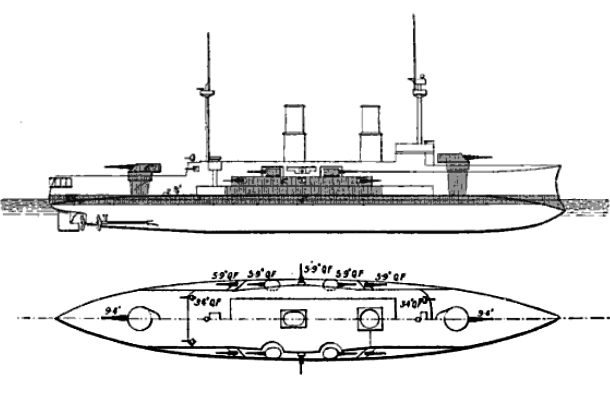
Line drawing, Brassey’s 1906
The armament was also hit by this cost rationale: Only two single turrets were kept, rather than the two twin turrets of the former Bismarck. The secondary artillery was also reduced but instead of spreading it in casemated positions along the hull (or sponsons) engineers had it concentrated in a single battery amidships, further reducing the amount of armor protection needed, saving weight and enabling thicker armor in that area. Adopting a smaller superstructure was another step to further cut back spending and weight whereas the heavy military masts were eliminated. Lighter pole masts were chosen, futher reducing weight and cost, and improving the ship’s metacentric height and stability overall. The machinery was improved however, up to 2,000 metric horsepower more powerful, which combined with the lesser weight made for a faster vessel.
All in all with all the meticulous details and thoughts which went into it, SMS Prinz Heinrich became a truly influential design, not only in Germany, for which all subsequent German armored cruisers were derived from her, but also she attracted interest abroad. Her armor layout even provided the basis for all future German capital ships, and for about forty years. Vizeadmiral Albert Hopman at the time however was not so full of praise, seeing her as “cheap, but bad” in his memoirs but this was denegated by German naval historians like Hans Hildebrand, Albert Röhr or Hans-Otto Steinmetz, pointing out her design at least equal if not superior to the French Desaix, Russian Bayan or Italian Garibaldi at the time, though still beneath British standards. Despite her innovative nature, her prewar career was quiet and her wartime career short, but she showed the way.
Hull & general characteristics
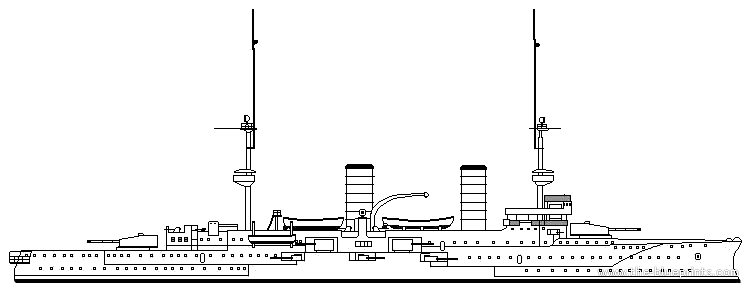
Reconstruction attempt (origin unknown, there was no conway’s profile done), from pinterest.ru
SMS Prinz Heinrich measured 124.9 meters (410 ft) -at the waterline- and 126.5 m (415 ft) overall, still with the trademark German “clipper-ram” bow, and 19.6 m (64 ft) wide with 7.65 m (25.1 ft) of draught forward, up to 8.07 m (26.5 ft) aft. Her nominal displacement was 8,887 metric tons (9,796 short tons), standard and up to 9,806 t fully laden. Construction of her hull called for transverse and longitudinal steel frames. Below the waterline, she was divided into thirteen watertight compartments with a double bottom over 57% of the hull. Tested in basin, the hull proven sound on trials, showing the behaviour of a good sea boat, stable with a gentle motion, but still severe roll with a transverse metacentric height of .731 m (2 ft 4.8 in).
Her crew comprised 35 officers and 532 ratings, and she served for most of her career as second command flagship for her Cruiser Division, the crew augmented by nine officers and 44 enlisted men in support. Her provision of small boats included two picket boats, a launch, a pinnace, two cutters, two yawls, and two dinghies. They were stored in two rows between funnels and behind the aft funnel, served by two goose cranes on either side, also use to trans-board supplies, coals and other payloads from the berth.
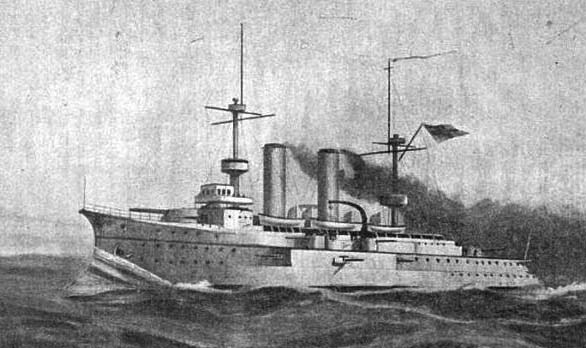
Engraving of the Prinz Heinrich
Powerplant
The Prinz Henrich was propelled by three vertical, four cylinder, triple expansion engines: There was a center one driving a shaft ending with a four-bladed screw, 4.28 m (14 ft) in diameter, use for cruising, and for top speed and manoeuvering, two outer shafts each ending with 4.65-meter (15.3 ft) wide four-bladed propellers. In total, these three VTE engines were fed by fourteen Dürr water-tube boilers from Düsseldorf-Ratinger Röhrenkesselfabrik. Thir working pressure was to 15 standard atmospheres (1,500 kPa). They were were ducted into two funnels amidships. In total, this powerplant was rated for 15,000 indicated horsepower (11,000 kW), enabling a top speed of 20 knots (37 km/h; 23 mph), not confirmed on sea trials though: Prinz Heinrich only reached 19.9 kn (36.9 km/h; 22.9 mph) based on 15,694 ihp (11,703 kW). Autonomy was function of her 900 tons of coal stored in peacetime, extended in wartime to 1,590 t using all available compartments. Her nominal range was 2,290 nautical miles (4,240 km; 2,640 miles) at 18 knots, up to 4,580 nmi (8,480 km; 5,270 miles) at 10 knots.
Armament of Prinz Heinrich
Primary:
-Two 24 cm (9.4 in) SK L/40 quick-firing guns, single turrets fore and aft.
-Depression −4°, elevation 30°, max. range 16,900 m (18,500 yd)
-Muzzle velocity 835 m (2,740 ft) per second
-75 rounds each, 140 kg (310 lb)
Secondary
–Ten 15 cm (5.9 in) SK L/40 quick-firing guns, 6 mounted in amidships casemates, four in turrets above the casemates.
-Elevation 25°, maximum range 13,700 m (15,000 yd), muzzle velocity of 800 mps (2,600 fts)
-120 rounds each, 40 kg (88 lb) AP shells.
Tertiary
–Ten 8.8 cm (3.5 in) SK L/30 quick-firing guns, for close defense.
-Elevation 20°, range of 7,300 m (8,000 yd), muzzle velocity 670 mps (2,200 fts)
-Each supplied by 250 shells, 7 kg (15 lb) HE shells.
–Four autocannons, 37 mm, also used as saluting guns and removable for landing parties, later removed.
–Four 45 cm (17.7 in) torpedo tubes: One mounted on the stern (swiveling), one submerged in the bow, one submerged broadside abreast of the forward gun turret.
Protection
SMS Prinz Heinrich as said above was protected by the brand new and revolutionary Krupp armor.
-Armor belt 100 mm (3.9 in), central portion, above the ammunition magazines, machinery spaces and vitals. It was backed by 80 mm teak planks.
-Outer belt 80 mm (3.1 in) until the bow and stern, unarmored.
-Armored decks 35-40 mm (1.4 to 1.6 in), connected by 50 mm slopes to the belt.
-Forward conning tower: 150 mm (5.9 in) walls, 30 mm (1.2 in) roof.
-Aft conning tower: 12 mm (0.47 in) walls.
-Main turrets: 150 mm sides, 30 mm roof.
-15 cm gun turrets: 100 mm sides and front
-15 cm casemates: 100 mm plating and 70 mm (2.8 in) shields.
Old author’s Profile of Prinz Heinrich
Prinz Heinrich Specifications |
|
| Dimensions | 127 x 20.4 x 7.8 m (416 oa x 66 x 25 ft) |
| Displacement | 10,690 t standard, 11,461 FL |
| Crew | 36 officers, 585 ratings |
| Propulsion | 3 shafts, 12 boilers, 3 VTE engines 13,500 ihp (10,100 kW) |
| Speed | 18.7 knots (34.6 km/h; 21.5 mph), Range: 3,230 nm (5,980 km)/12kts |
| Armament | 2×2 24 cm (9.4 in), 12 × 15 cm (5.9 in), 10 × 8.8 cm (3.5 in) SK L/30, 6 × 45 cm (18 in) TTs |
| Armor | Belt: 20 cm (7.9 in), Turrets: 20 cm (7.9 in), Deck: 3 cm (1.2 in) |
Read More:
Extra photos on deutsche-schutzgebiete.de
On german-navy.de
The Model Corner:
Navis Neptun 34N SMS Prinz Heinrich, Armoured Cruiser, 1910 1/1250
A nice model in silver of the cruiser in auction
The Prinz Heinrich in service
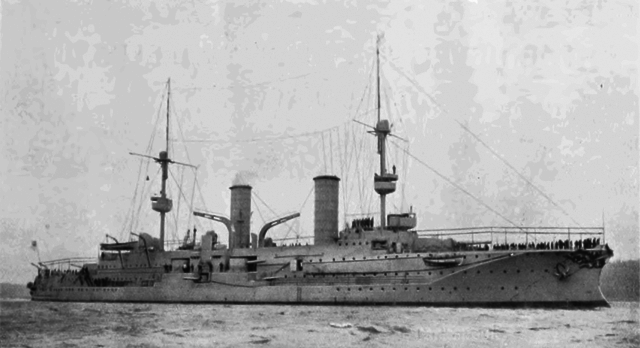
A photo of Prinz Heinrich from Page’s Magazine, 1902
Interwar career
Seiner Majestät Schiffe Prinz Heinrich was laid down on 1 December 1898 at Kaiserliche Werft (the Imperial Shipyard), Kiel. Launched on 22 March 1900 her namesake Prince Heinrich of Prussia was attending at the launching ceremony as well as Generalinspekteur der Marine Admiral Hans von Koester, which gave a speech at this occasion. Completed was done two years later on 11 March 1902 and she started sea trials until June, commissioned and affected to reconnaissance forces, Ist Squadron as flagship. Training exercize and her first shakedown cruise in Norwegian waters brought her to 20 July and by Augus she escorted the yacht Hohenzollern in Russia, meeting Czar Nicholas II in Reval. SMS Prinz Heinrich in September became flagship of 2nd Scouting Group (also cruisers Niobe, Nymphe) and from 18 September as Kurfürst Friedrich Wilhelm was in maintenance she took her place as flagship hoisting the mark of counter-admiral Curt von Prittwitz und Gaffron, later replaced by KAdm Ludwig Borckenhagen in October. During her winter training cruise she attempted to pull SMS Wittelsbach free on 17 December after running aground in the Great Belt. The new Commander of Scouting Forces became Ludwig Borckenhagen and Prinz Heinrich remained her flagship on 1 March 1903.
She commanded a squadron also comprising the protected cruiser Victoria Louise, and light cruisers Amazone and Ariadne and from 12 April, SMS Medusa, in May Frauenlob and Niobe. After autumn fleet maneuvers (August-September) Borckenhagen was replaced by KAdm Gustav Schmidt and this was followed by various fleet training activities, and a visit to Spain in May-August. Upon returning hom took place the annual training exercises until 22 September. On 25 January 1904, SMS Prinz Heinrich sent a land party to help the Norwegian town of Ålesund after a massive fire. In mid-1904, SMS Friedrich Carl joined the Reconnaissance Force and after the autumn maneuvers in which Prinz Heinrich won the Schiesspreis (Shooting Prize) for accuracy, in December, Schmidt transferred his flag to Friedrich Carl, a more modern armoured cruiser.
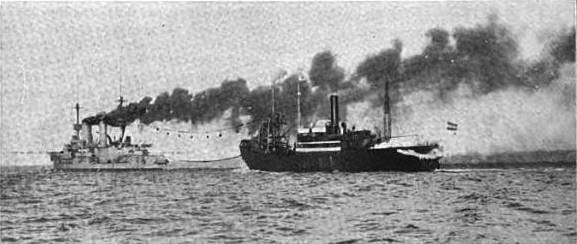
Prinz Heinrich coaling from the collier Hermann Sauber
1905 was a quiet year without incident of note, but on 20 June, Prinz Heinrich became flagship again, Friedrich Carl escorting the Hohenzollern abroad. by July, SMS Prinz Heinrich experimented a new coaling apparatus and tests went on until February 1906. She was flagship again in August (as Friedrich Carl was drdocked in maintenance). On 1st October, the post of Deputy Commander of Scouting Forces was created. By that time, SMS Prinz Heinrich Kapitän zur See Raimund Winkler was nominated and replaced. In March 1906, she left the reconnaissance sqn., replaced by Friedrich Carl, and later Yorck, and she was sent in reserve for two years. Reactivated on 15 May 1908 she replaced the gunnery training ship SMS Mars, based in Sonderburg from 22 June, for the Naval Artillery Inspectorate. She served in this guise four years, always static in port, until replaced by the armored cruiser Prinz Adalbert in October 1912. By that time she was was decommissioned on 31 October 1912 and reactivated in November 1913, as the admiralty wanted to converter her as a dedicated training vessel, but with an easy conversion plan for wartime, back as operational cruiser. By early 1914, the plans were ready and approved, and she was drydocked for this conversion at the Kaiserliche Werft. The searchlights’s positions and model was altered, the superstructure deck bulwark removed, masts modernized and other details. This was over in July 1914.

Prinz Heinrich passing through the Kaiser Wilhelm Canal
WW1 career
SMS Prinz Heinrich was reactivated for wartime service and returned, just barely out, to Kiel’s shipyard for preparation work back to fully operational cruiser. Once over, she was assigned to the defense of Kiel, expecting a British attack on 25–26 September. The armoured cruiser was assigned to III Scouting Group of the Hochseeflotte. Starting on 8 November 1914, and until 14 April 1915, she was basically a guard ship, patrolling the Jade Bay and river Ems. She participated however in the shelling of Hartlepool, 15–16 December 1914. Along with Roon TBs she was to the van of the High Seas Fleet under command of Admiral Friedrich von Ingenohl, providing distant cover for von Hipper’s battlecruisers. On the 15 during the night, they came about 10 nmi (19 km; 12 mi) of a British squadron of six battleships and skirmishes too place between their destroyer screens. Von Ingenohl thought it was the entire Grand Fleet and was recalled by Kaiser Wilhelm II to avoid risking his fleet.
In April 1915 the admiralty decided Prinz Heinrich was too old to take part in future operations with the Hochseeflotte and on 12 April 1915, and followed the III Scouting Group to the Baltic Sea, in the quieter sector against the Russian Fleet. On 15 April they arrived in Kiel, and KAdm Hopman, took command.He planned an attack on Libau to cover the German Army approaching, and it started on 7 May. Outside Prinz Heinrich, the Roon, Prinz Adalbert, and the old coast guard Beowulf, plus the light cruisers Augsburg, Thetis, and Lübeck participated in the attack. With them, was a flotilla of destroyers, torpedo boats and minesweepers which tried to clean up the access to Libau. The IV Scouting Group provided cover for it and the shelling commenced, the only casualty being the destroyer V107, hit by a mine in the harbor. The army eventually took the city as planned.
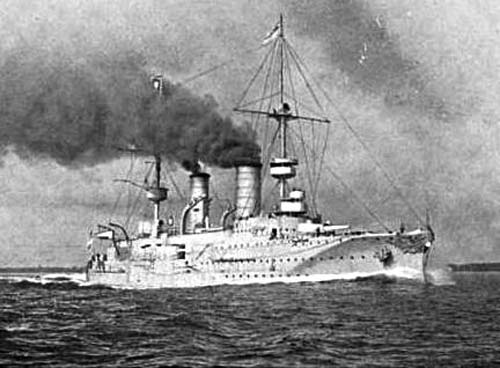
Prinz Heinrich steaming at high speed
Prinz Heinrich next was sent to support a minelaying operation off the coast of Finland. It happen soon after, in 23–26 May 1915. On 3-5 June, she made a swoop in the Gulf of Finland and covered another minelaying operation in 20-23 June. On 1st July, following a sortie of the minelayer SMS Albatross north of Bogskär, the force split and Augsburg and Albatross were intercepted by a Russian squadron (Rear Admiral Bakhirev) with three armored crusier, two light. Johannes von Karpf ordered Albatross to reach neutral Swedish waters and Roon and Lübeck recalled. SMS Albatross eventually was grounded off Gotland while Roon exchanged fire briefly before leaving. Hopman rushed out with Prinz Heinrich and Prinz Adalbert to try to locate Albatross and cover her, possibly tow her to safety. En route they were ambushed by the submarine E9, which torpedoed Prinz Adalbert and the operation was cancelled. The intelligence provided by Albatros proved invaluable for the entente.
On 11-12 July, Prinz Heinrich was part of the raid on Gotska Sandön, but no encounter with the Russians was made. Next this was in the central Baltic between Libau and Gotland, 1-2 August for the same result. Some ships from the Hochseeflotte joined them during the Battle of the Gulf of Riga in August 1915, over the laying of defensive minefields blocking any Russian sortie there. Battleships of the Ist Battle Squadron were covered by Prinz Heinrich and other cruisers. On 10 August, Prinz Heinrich and Roon shelled Zerel at the southernmost tip of the Sworbe Peninsula (Ösel island). Several Rissian destroyers there were damaged. But both a tenacious Russian coastal defense and British submarine reports following the torpdeoing of the battlecruiser Moltke on 19 August cancelled the ongoing operation.
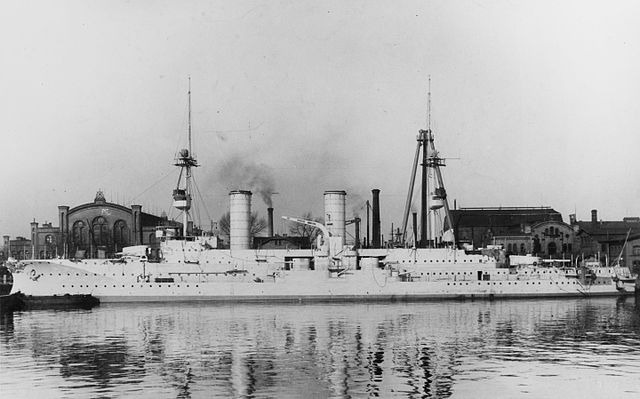
SMS Prinz Heinrich in port
Prinz Heinrich wasn sent in drydock to have her worn out boiler tubes replaceed in Kiel, from 11 August to September, arriving in Libau on the 22th. She covered a minelaying sortie towards Östergarn on 5–6 October, but severe crew shortages pushed the Reichsmarineamt to decommission older ships, and this fell on 10 November on Prinz Heinrich. She was ordered to Kiel, and after her crew was curtailed, she was assigned to the “Readiness Division”, along with the pre-dreadnought, SMS Wittelsbach. She remained there until 27 March 1916 befote full decommission and disarmament. Her guns were badly needed on the western front. She served as a floating headquarters, Barrack ships and tender, hositing the mark of her namesake Prince Heinrich, promoted as commander in chief of Baltic naval forces. In 1918, she became an U-Boat tender, for the U-Kreuzer Flotilla (large long range cruiser submarines). She was stricken on 25 January 1920, sold in 1921 to Audorf-Rendsburg and scrapped.

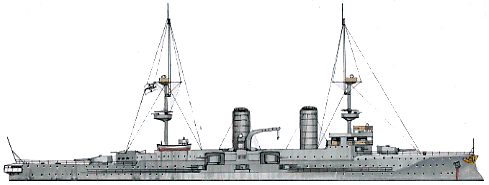
 Latest Facebook Entry -
Latest Facebook Entry -  X(Tweeter) Naval Encyclopedia's deck archive
X(Tweeter) Naval Encyclopedia's deck archive Instagram (@navalencyc)
Instagram (@navalencyc)





 French Navy
French Navy Royal Navy
Royal Navy Russian Navy
Russian Navy Armada Espanola
Armada Espanola Austrian Navy
Austrian Navy K.u.K. Kriegsmarine
K.u.K. Kriegsmarine Dansk Marine
Dansk Marine Nautiko Hellenon
Nautiko Hellenon Koninklije Marine 1870
Koninklije Marine 1870 Marinha do Brasil
Marinha do Brasil Osmanlı Donanması
Osmanlı Donanması Marina Do Peru
Marina Do Peru Marinha do Portugal
Marinha do Portugal Regia Marina 1870
Regia Marina 1870 Nihhon Kaigun 1870
Nihhon Kaigun 1870 Preußische Marine 1870
Preußische Marine 1870 Russkiy Flot 1870
Russkiy Flot 1870 Svenska marinen
Svenska marinen Søværnet
Søværnet Union Navy
Union Navy Confederate Navy
Confederate Navy Armada de Argentina
Armada de Argentina Imperial Chinese Navy
Imperial Chinese Navy Marinha do Portugal
Marinha do Portugal Mexico
Mexico Kaiserliche Marine
Kaiserliche Marine 1898 US Navy
1898 US Navy Sovietskiy Flot
Sovietskiy Flot Royal Canadian Navy
Royal Canadian Navy Royal Australian Navy
Royal Australian Navy RNZN Fleet
RNZN Fleet Chinese Navy 1937
Chinese Navy 1937 Kriegsmarine
Kriegsmarine Chilean Navy
Chilean Navy Danish Navy
Danish Navy Finnish Navy
Finnish Navy Hellenic Navy
Hellenic Navy Polish Navy
Polish Navy Romanian Navy
Romanian Navy Turkish Navy
Turkish Navy Royal Yugoslav Navy
Royal Yugoslav Navy Royal Thai Navy
Royal Thai Navy Minor Navies
Minor Navies Albania
Albania Austria
Austria Belgium
Belgium Columbia
Columbia Costa Rica
Costa Rica Cuba
Cuba Czechoslovakia
Czechoslovakia Dominican Republic
Dominican Republic Haiti
Haiti Hungary
Hungary Honduras
Honduras Estonia
Estonia Iceland
Iceland Eire
Eire Equador
Equador Iran
Iran Iraq
Iraq Latvia
Latvia Liberia
Liberia Lithuania
Lithuania Mandchukuo
Mandchukuo Morocco
Morocco Nicaragua
Nicaragua Persia
Persia San Salvador
San Salvador Sarawak
Sarawak Uruguay
Uruguay Venezuela
Venezuela Zanzibar
Zanzibar Warsaw Pact Navies
Warsaw Pact Navies Bulgaria
Bulgaria Hungary
Hungary

 Bundesmarine
Bundesmarine Dutch Navy
Dutch Navy Hellenic Navy
Hellenic Navy Marina Militare
Marina Militare Yugoslav Navy
Yugoslav Navy Chinese Navy
Chinese Navy Indian Navy
Indian Navy Indonesian Navy
Indonesian Navy JMSDF
JMSDF North Korean Navy
North Korean Navy Pakistani Navy
Pakistani Navy Philippines Navy
Philippines Navy ROKN
ROKN Rep. of Singapore Navy
Rep. of Singapore Navy Taiwanese Navy
Taiwanese Navy IDF Navy
IDF Navy Saudi Navy
Saudi Navy Royal New Zealand Navy
Royal New Zealand Navy Egyptian Navy
Egyptian Navy South African Navy
South African Navy






























 Ukrainian Navy
Ukrainian Navy dbodesign
dbodesign